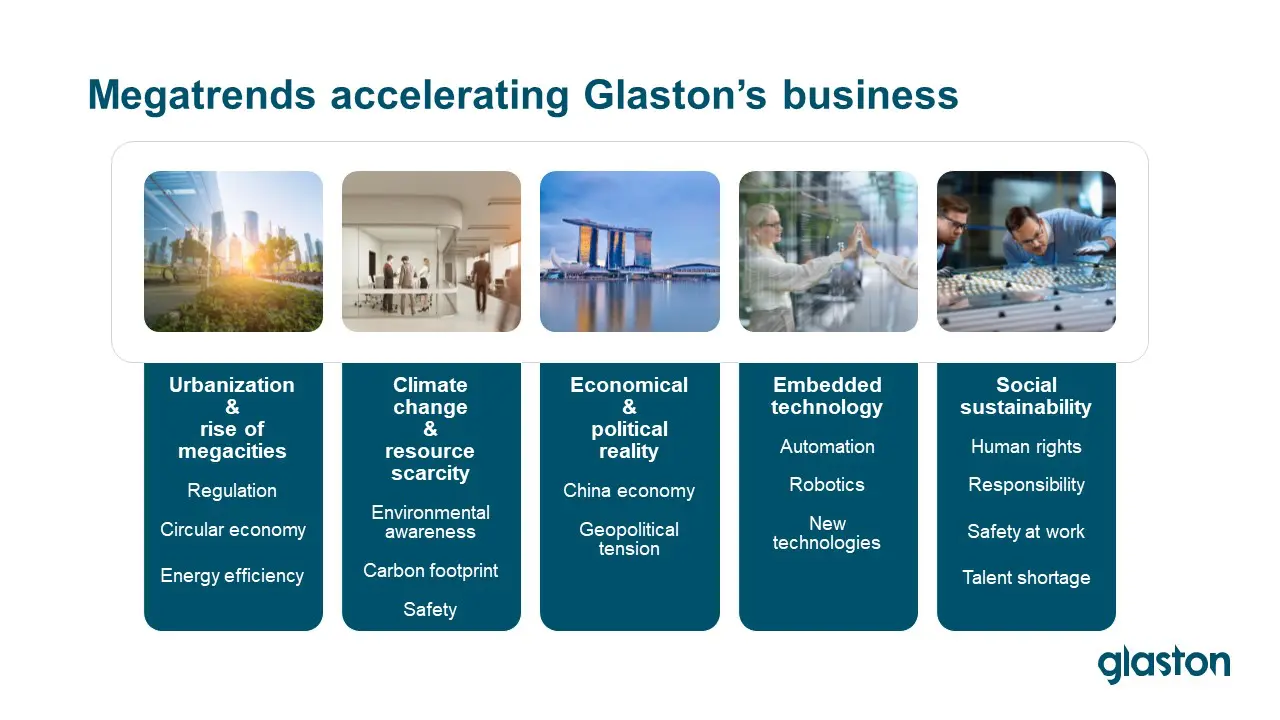Market Information
Operational Environment
Glaston is a frontrunner in glass industry technologies and services, responding globally to the glass processing needs of the architectural, solar, display and automotive industries. Demand for Glaston’s products and services is dependent on demand for glass and glass processors’ capacity. Glaston estimates that in 2024, the Architectural markets declined in EMEA and China, while the rest of APAC and Americas performed slightly better. The mobility market grew strongly in China and declined elsewhere.
Use of glass in construction is increasing through urbanization. Special requirements for glass are growing due to changing environmental factors, increasing safety regulations and energy-efficiency demands.
In the automotive industry, the relative proportion of glass in vehicles is growing and use of thin glass, in particular, is increasing. Growth of solar energy, smart glass and energy-efficient glass is being supported by increasing environmental awareness and investments in renewable energy.
Glass processed using Glaston’s processing machines is supplied to the architectural glass, mobility glass, solar energy and display industries. Most of the glass produced with the company’s technology is supplied to the architectural glass industry.
Glaston operates in a global market, and the company’s business is to a large extent linked to trends in global investment demand.
Markets
In 2024, the market environment was challenging. The Architectural market remained soft, and EMEA was particularly affected by the weaker market environment. The Mobility market, in China mainly, developed well, supported by their transition to electric vehicles.
Glaston has divided its market areas into EMEA, America, and APAC. The EMEA area has traditionally been a strong market for Glaston and in 2024, it generated approximately 44% of Glaston’s net sales. In 2024 Americas’ share of the company’s total revenue was approximately 31% and APAC’s share 25%.
Due to the slowdown in the residential and commercial glass markets, the architectural glass market was slow throughout 2024. As a result of weaker market prospects and continuing economic uncertainty, customers’ investment hesitation continued.
EMEA suffered the most of market uncertainty. In the Americas, the residential market showed some signs of a slowdown. In China, the markets were soft throughout the year. Elsewhere in the APAC area, market activity improved in many countries compared to the previous year.
Supported by the transition to electric vehicles, the Chinese mobility market was active throughout 2024 with a majority of the world’s mobility glass value chain investments taking place in China. However, a significant part of the investment demand in China is driven by the high expectations for electric vehicle sales outside of China, and potential tariffs increase market uncertainty and cause volatility. Market activity remained at very low levels in the rest of the world.
Competitors
The glass technology market is still fragmented and Glaston has many competitors. However, due to the challenging market situation, consolidation has accelerated in recent years.
The glass processing technology market is highly fragmented, with many small players manufacturing and selling machines and solutions to different parts of the flat glass processing chain.
The market can be divided into the high-end segment, mid-market segment and low performance segment in accordance with the customers’ quality and performance standards for the product. Glaston’s main addressable markets are the high-end and mid-market segment. Glaston estimates that in the high-end market segment, the customers have the highest requirements for machine capacity, uptime and services, as well as the highest quality requirements for the end product.
In the mid-market segment, the glass processors are usually regional or local processors and the quality requirements for the end product are lower than in the high-end segment.
Glaston’s main competitors are from Europe, China and Japan. For heat treatment equipment, Glaston’s main competitors are from China, for insulating glass equipment, the main competitors are from Central Europe and for automotive equipment, the main competitor is located in Japan.
In the Services business area, Glaston’s customer service network is the sector’s most extensive both geographically and in terms of personnel. There are more than 20 service locations. In addition, the service range provided by the Services business is the most comprehensive in the sector. Glaston’s comprehensive Glaston Care service agreements distinguish Glaston from its competitors. Maintenance services are available for every stage of the life cycle of products.

